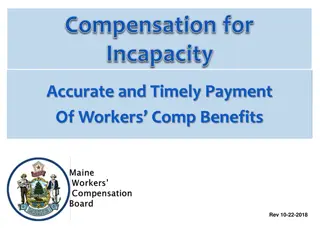Understanding the Workers' Compensation Audit Process in Maine
Explore the Maine Workers' Compensation Board's audit process, which aims to ensure compliance with the Workers' Compensation Act through random selection, thorough planning, sample determination, and testing for form filing, timeliness of payments, and accuracy. An auditor employed by the Board conducts the audit, recommending corrective actions as needed.
Download Presentation

Please find below an Image/Link to download the presentation.
The content on the website is provided AS IS for your information and personal use only. It may not be sold, licensed, or shared on other websites without obtaining consent from the author. Download presentation by click this link. If you encounter any issues during the download, it is possible that the publisher has removed the file from their server.
E N D
Presentation Transcript
The Audit Process Maine Workers Compensation Board Web Feb 2016
Glossary of Terms Board Maine Workers Compensation Board CAP - Corrective Action Plan CFA Complaint For Audit DCI Spreadsheet Detailed Claims Information Entity insurer, self-insurer, employer, TPA
Purpose Of The Compliance Audit To ensure that the entity being audited is meeting its obligations under the Workers Compensation Act in regards to: Form filing Timeliness of indemnity payments Accuracy of indemnity payments Timeliness and accuracy of medical bill payments To identify other significant issues To recommend appropriate actions
How is The Entity Chosen For Audit? Chosen on a random basis on a three year cycle Complaint for Audit Corrective Action Plan
Who Performs The Audit? An auditor employed by the Board, having adequate knowledge in the subject matter, and adequate technical training and proficiency in the attest function Supervised by the Audit Manager Independent in mental attitude
Planning & Preliminary Steps License check entity and individual adjusters Review last Audit Report Check for CFA or CAP Compliance check FROI, MOP, NOC Engagement letter Pre-audit survey Develop audit sample
How Is The Audit Sample Determined? Compare entity report with Board records 50% of indemnity claims in previous year Maximum 60 claims Expand to 100% in last 3 years for Tier 3 entities 60 Medical payments Random sample Obtain Board files and entity files Desk audit or on-site audit
Testing Form Filing Review timeliness, accuracy, completeness Check for forms required but not filed Timeliness of Indemnity Payments Initial payment mailed within 14 days of notice or knowledge of claim Subsequent payments weekly (every 7 days) Agreements or decisions due within 10 days
Testing(continued) Accuracy of Indemnity Payments AWW and WCR Waiting period Late filed NOC Maximum benefit adjusted July 1 Date of injury paid day? Modification or discontinuance
Testing(continued) Medical payments Paid within 30 days Paid in accordance with medical fee schedule
Other Significant Issues Examples Licensing or jurisdiction issues Incorrect dates / misleading information Reporting interest / penalties as weekly compensation on the WCB-11 Improper recovery of overpayments Failure to cooperate with auditor s requests Failure to comply with record retention requirements
Exit Conference Summary of audit findings Request for additional forms & information Request for payment to employees and/or medical providers for claims found to be underpaid Penalty exposure Missing/late forms Missing/late benefit payments Questionable claim handling techniques Fraud or willful violation
Penalty Exposure 205(3) Delays in payment - $50 per day 324(2)(A) Failure to pay - $200 per day 359(2) Questionable claims handling - $25,000 360(1)(A) Forms required but not filed - $100 each 360(1)(B) Forms filed late - $100 each 360(2) Willful violation or fraud - $10,000
Questionable Claims-Handling Examples Chronic failure to file forms or file timely Excessive errors on reconciliation responses Chronic incomplete/inaccurate/inconsistent information on Board filings Chronic payment delays Chronic inaccuracy of benefit payments Pattern of excessively low provisional rates Chronic late or inaccurate payment of medical bills
Audit Report Issued as a draft until accepted and agreed upon by the entity and the Board Indicates compliance percentages for: All forms Timeliness of initial, subsequent, and other payments Accuracy of AWW, WCR, partial benefits, and total indemnity paid Timeliness & accuracy of medical payments Subject to rebuttal and/or negotiation by the entity Issued and published as a final report when accepted by the entity























